Originally published last year -- Enjoy!
Recently, the United States has seen an explosion of ‘e-cigarette’ use in most major cities which has called into question the health concerns associated with such devices. There has been dialogue back and forth regarding banning such devices and classifying the electronic cigarette products in the same class as cigarettes. In the last few months, I have been thinking about the emerging trend as I have seen people around me using ‘vaporizers’ underneath the banner of the slogan “a healthier way to reduce your cigarette addiction.” Along this line of thought, a product market of supplies (flavored liquid nicotine, delivery devices, etc.) has emerged in order to meet this increase in demand. There is little dispute of the fact that nicotine is a drug and is extremely addictive as noted in past litigation of the tobacco companies. The general public most likely is unaware that the lethality of this neurotoxin could potentially kill or cause adverse health effects with the current tobacco products (volumes of liquid nicotine) that are sold on the market.
The following is a calculation driven approach to compare the nicotine levels contained in such products with the nicotine levels in cigarettes. By understanding the amount of nicotine that is in such products, the public might be in a better position to make a more informed decision or opinion regarding public banning or policy based decisions associated with this emerging trend of use of tobacco products.
E-cigarette Products Vary In Nicotine Concentration
I was reading an article out of The New York Times a couple of weeks ago that discussed the range of volumes of liquid nicotine that were available for purchase at a few sites. The title of the article was ‘Selling a Poison by the Barrel: Liquid Nicotine for E-Cigarettes’ (click here to view original article). Here is an excerpt describing the potential problem from the article:
A dangerous new
form of a powerful stimulant is hitting markets nationwide, for sale by the
vial, the gallon and even the barrel.
The
drug is nicotine, in its potent, liquid form — extracted from tobacco and
tinctured with a cocktail of flavorings, colorings and assorted chemicals to
feed the fast-growing electronic cigarette industry.
These
“e-liquids,” the key ingredients in e-cigarettes, are powerful neurotoxins.
Tiny amounts, whether ingested or absorbed through the skin, can cause vomiting
and seizures and even be lethal. A teaspoon of even highly diluted e-liquid can
kill a small child.
After reading this far into the article above, I wondered what the range of concentration was of nicotine available for sale in a given volume sold either at a smoke shop or online vendor. Over the past few months, I have watched a few of my friends load or fill up their e-cigarettes or vaporizers with liquid nicotine. I wondered about the types of chemicals that were mixed into the vials to provide such an attractive volatile sensory perception (through both taste and smell) to a consumer. Further, I was concerned about the type of chemicals that the smoke contained. That is another blog topic in another post waiting to be written.
In the article from above, the excerpt gave a range of concentrations by volume as described in this excerpt below:
The nicotine levels in e-liquids varies. Most range between 1.8 percent and 2.4 percent, concentrations that can cause sickness, but rarely death, in children. But higher concentrations, like 10 percent or even 7.2 percent, are widely available on the Internet. A lethal dose at such levels would take “less than a tablespoon,” according to Dr. Cantrell, from the poison control system in California. “Not just a kid. One tablespoon could kill an adult,” he said.
By the end of the story in the newspaper, my interest in figuring out the cause of concern with various concentrations of nicotine sold in e-liquid products was at the maximum. I was determined to get more information than what was offered in the story I just read in order to have a better understanding of all of this media hype surrounding the emerging use of e-liquid nicotine products. To start my query, I thought the appropriate first step would be to the percent composition of nicotine stated above in the article (1.8-2.4 percent nicotine). I compared this range of percent composition expressed from the typical labeling of 18-24 mg/mL found vials or volumes online to the equivalent amount of nicotine found in a cigarette.
How many cigarettes correspond to the concentration of nicotine found in E-cigarette products?
To compare nicotine concentrations of cigarettes and the e-liquids for vaporizers, one must know the amount of nicotine found in both. I looked up the value in a journal article that cited a study by the National Insititutes of Health that cited a concentration to be 2.5 mg per cigarette (click here for original article). That is 2.5 milligrams of nicotine per cigarette that is inhaled by a person smoking a cigarette. Now that I had an average amount of nicotine found in a cigarette, I could compare concentrations of various amounts that were sold either in shops or online. Going back to the range listed of 1.8-2.4 % or 18-24 mg/mL the following calculations can be performed to figure out how many cigarettes this range corresponds to:
At first glance these numbers do not seem large at all? To really understand the context (of the initial article above) of how these numbers the range of 18-24 mg/mL correspond to 7.2-9.6 cigarettes, we need to look at the available volumes that consumers are purchasing online or in a store to refill their e-cigarettes and vaporizers. I looked at the online website listed in the article ‘vaporworld.biz’ and chose to purchase (or act like I was going to) a small amount of ‘banana split e-liquid’ (click here for the link to the purchase page). There are two ranges listed on the menu to choose in the process of making a purchase on this site: a desired volume and nicotine concentration. The volumes (in mL) available are: 12, 22, 32, and 52. The available nicotine concentrations (in mg/mL) are: 6, 12, 18, and 24 mg/mL. Looking at these numbers, I was wondering how best to approach understanding the ranges.
I chose to look at the values of both volume and concentration in the following way: lowest volume-lowest concentration, highest volume-lowest concentration, lowest volume-highest concentration, highest volume-highest concentration. I figured that this would form two ranges of concentrations—that of the lowest and the highest. Shown below are the calculations performed to establish the ranges of concentrations of nicotine sold in vials in increasing order.
Why is this approach important?
The reason is that these two ranges will
correspond to a consumer who is buying at the low end and high end of each side
of the range of nicotine levels. Meaning,
if a consumer is a constant user of a vaporizer, then the choice of a purchase
to stock their supply might be from the low concentration of nicotine (6
mg/mL). On the other side of the range
would be for a consumer that is not a high frequency user of a vaporizer or
e-cigarette but would like to have a few inhalations briefly at intervals
throughout the day. The latter consumer
would make up the high end of the range of nicotine concentration.
Summarizing the tabulated values of the
numbers given above produces two ranges of concentrations of nicotine available
for purchase on the site listed above.
The low range of concentration would be 72-312 mg of nicotine for the
consumer purchasing the lowest concentration of 6 mg/mL. While the high range would be 288-1248 mg of
nicotine sold with a concentration of 24 mg/mL.
As stated above and calculated, I chose to see these two ranges in a
more accessible manner—which is the equivalent number of cigarettes with the
same ranges of concentration of nicotine.
The equivalent ranges expressed in the number of cigarettes are: low
concentration range (29-125 cigarettes) and high concentration range (115-500
cigarettes).
These numbers have significance from a
health and safety standpoint. If any of
these purchased bottles were left out on the ‘coffee table’ or ‘bedstand’ for a
passing child to grab and consume or spill on themselves, the above amounts
would be absorbed (either by absorption through the skin or swallowed and
absorbed in the stomach) and be potentially life threatening. In the article, the author stated the fact
that these products are not regulated by the FDA or any other Federal agency
yet. This leads me to my next question:
How do I know if these levels of nicotine are dangerous or life-threatening?
What Level Of Nicotine Is Life Threatening?
In the above excerpt from the newspaper article a physician stated that less than a ‘tablespoon’ could kill an adult. Again, what does this mean to the average person reading this article? Upon reading this statement, I wondered what is the lethal dose of nicotine to kill an adult? The lethal dose to kill a species is best expressed by toxicologists as the ‘LD50 level’. This is the ‘median level of lethality’ which corresponds to the amount of a substance required to kill 50 % of the tested population during a given toxicity experiment. For nicotine in human consumption, the LD50 level is around 0.8 mg/kg of body weight.
To put this value into perspective, I chose to look at the
amount of nicotine that would be needed to cause life threatening injuries to
the following weights and ages of the U.S. population: 4 yr old girl (30
pounds), 4 yr old boy (48 pounds), a female adult (140 pounds), and an adult
male (200 pounds). Here are the
concentrations of nicotine needed expressed in milligrams based on the LD50
given above shown below.
How does one make sense of these numbers calculated
above?
First, the number of cigarettes
tabulated should not be drawn out of perspective when glanced at. Yes, the number is low compared to the levels
of nicotine above. The amount needed to
cause life-threatening injuries is quite small.
Although, the amount must be 100% absorbed through the skin all in a
short time period or absorbed in the stomach lining instantaneously. Still, by inspection of the calculated
concentrations—the corresponding amounts are very low and should stick in
consumer’s when considering keeping a stock pile of nicotine refills or other
products around the house.
After calculating these values, I now can make sense of the
statistics of accidents that were stated in the above article:
Reports of accidental poisonings, notably among children, are soaring. Since 2011, there appears to have been one death in the United States, a suicide by an adult who injected nicotine. But less serious cases have led to a surge in calls to poison control centers. Nationwide, the number of cases linked to e-liquids jumped to 1,351 in 2013, a 300 percent increase from 2012, and the number is on pace to double this year, according to information from the National Poison Data System. Of the cases in 2013, 365 were referred to hospitals, triple the previous year’s number.
These numbers clearly
correspond with the calculated values that were shown to make sense of the
concentrations of nicotine that are emerging in both local tobacco shops and
online vendors. If the public does not
start moving in the form of any type of regulation at the Federal Agency level,
an increase in tragedies is all one can foresee in the future. In the meantime before action is taken
locally or proposed at the federal level, the consumer can be CAUTIOUS both for
their own sake aside from that of others around them (children, spouses,
siblings, etc.). There are forums online
which discuss the hazards of e-cigarettes and vaporizers along with the
available accessories that are sold online.
A forum I found particularly useful in obtaining statistics and
information that motivated the writing of this blog was located at the
following web address: www.e-cigarette-forum.com.
The website has plenty of information regarding the emerging trends of
e-cigarettes/vaporizers.
I will leave you with this last calculation based a fact that I did not have a chance to cover. Aside from pre-mixed e-liquids there are amateurs that would choose to mix their own concentrations of nicotine with a desired flavor. In the article cited above, the highest concentrations of nicotine and volumes reported were 10% by volume (corresponding to 100 mg/mL) and 55 gallons available for sale online. I calculated the concentration of nicotine in 55 gallons to be:
I will leave you with this last calculation based a fact that I did not have a chance to cover. Aside from pre-mixed e-liquids there are amateurs that would choose to mix their own concentrations of nicotine with a desired flavor. In the article cited above, the highest concentrations of nicotine and volumes reported were 10% by volume (corresponding to 100 mg/mL) and 55 gallons available for sale online. I calculated the concentration of nicotine in 55 gallons to be:
Wow, I am amazed at the magnitude of 8.3 million cigarettes
corresponding to the amount of nicotine that is in a 55 gallon drum sold
wholesale. I think that the numbers
speak for themselves in relation to the danger posed. Have a great day.
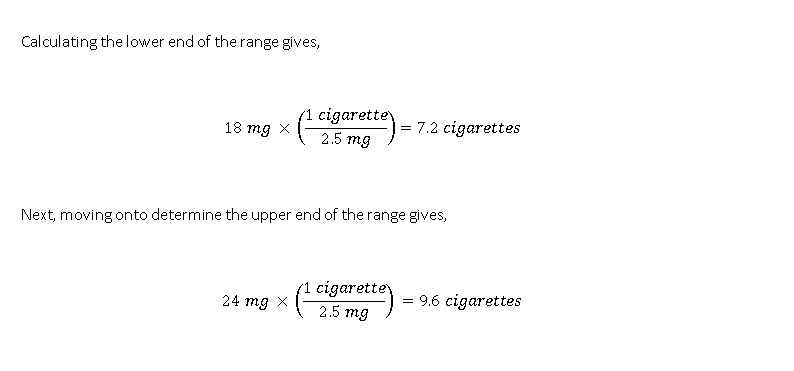
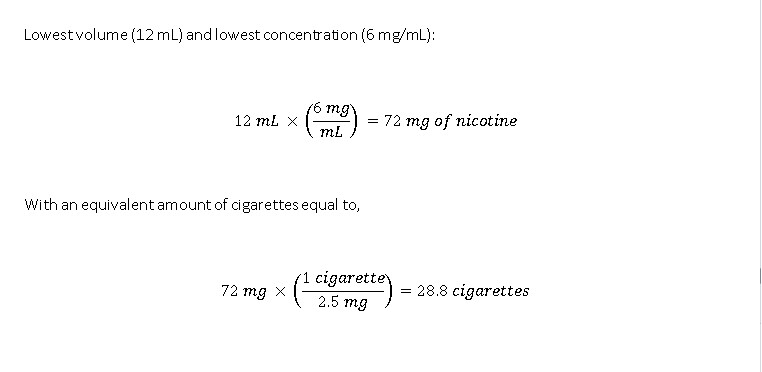
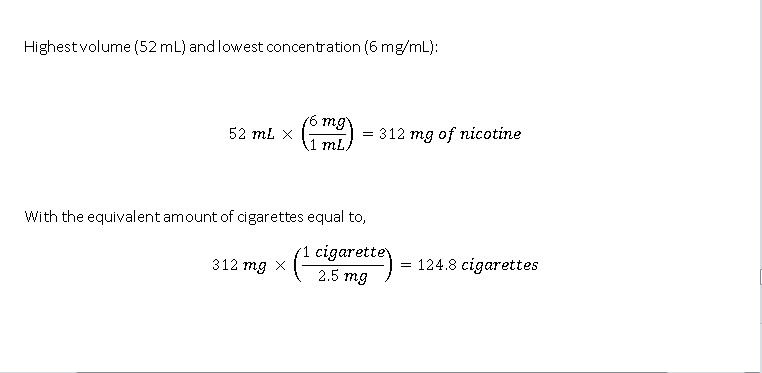

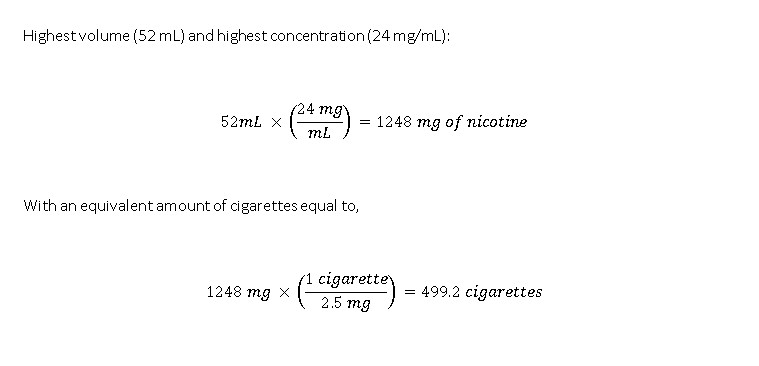
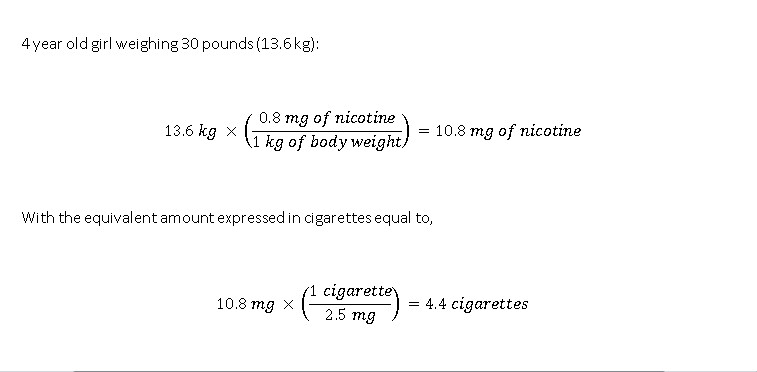

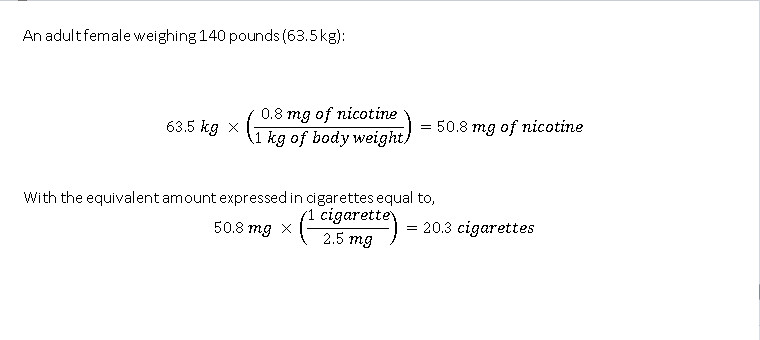
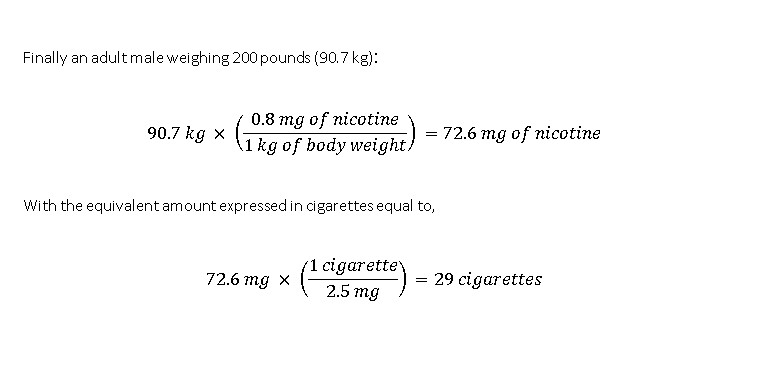
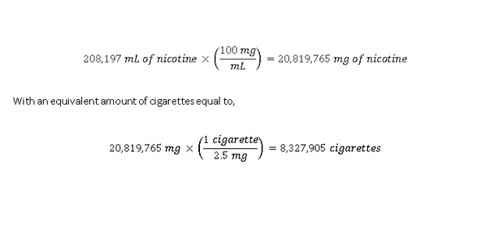
ReplyDeleteThe first is to find something healthy with which to replace cigarettes for alleviating your discomfort.
Cigarettes really don't have to control our lives.
Take a look: how much nicotine is in a cigarette
Hello Alam,
DeleteI agree to a large extent. Although, the idea that e-cigarettes are not dangerous is extremely misleading. New research is emerging showing that the breakdown products under heat in e-liquids are quite harmful. Therefore, as new science emerges, the use of e-cigarettes as a "healthy solution" to quitting smoking becomes less convincing and more concerning.
Thank you for the comment. Have a great day.
Sincerely,
Mike
Hello Alam,
DeleteI agree to a large extent. Although, the idea that e-cigarettes are not dangerous is extremely misleading. New research is emerging showing that the breakdown products under heat in e-liquids are quite harmful. Therefore, as new science emerges, the use of e-cigarettes as a "healthy solution" to quitting smoking becomes less convincing and more concerning.
Thank you for the comment. Have a great day.
Sincerely,
Mike
Your blog provided us with valuable information to work with. Each & every tips of your post are awesome. Thanks a whole lot for sharing. Keep blogging.. vaping experience can become better than before by adding the flavor that suits your taste. There are so many flavour in which you can select the level of nicotine according to your need. e-liquide
ReplyDelete